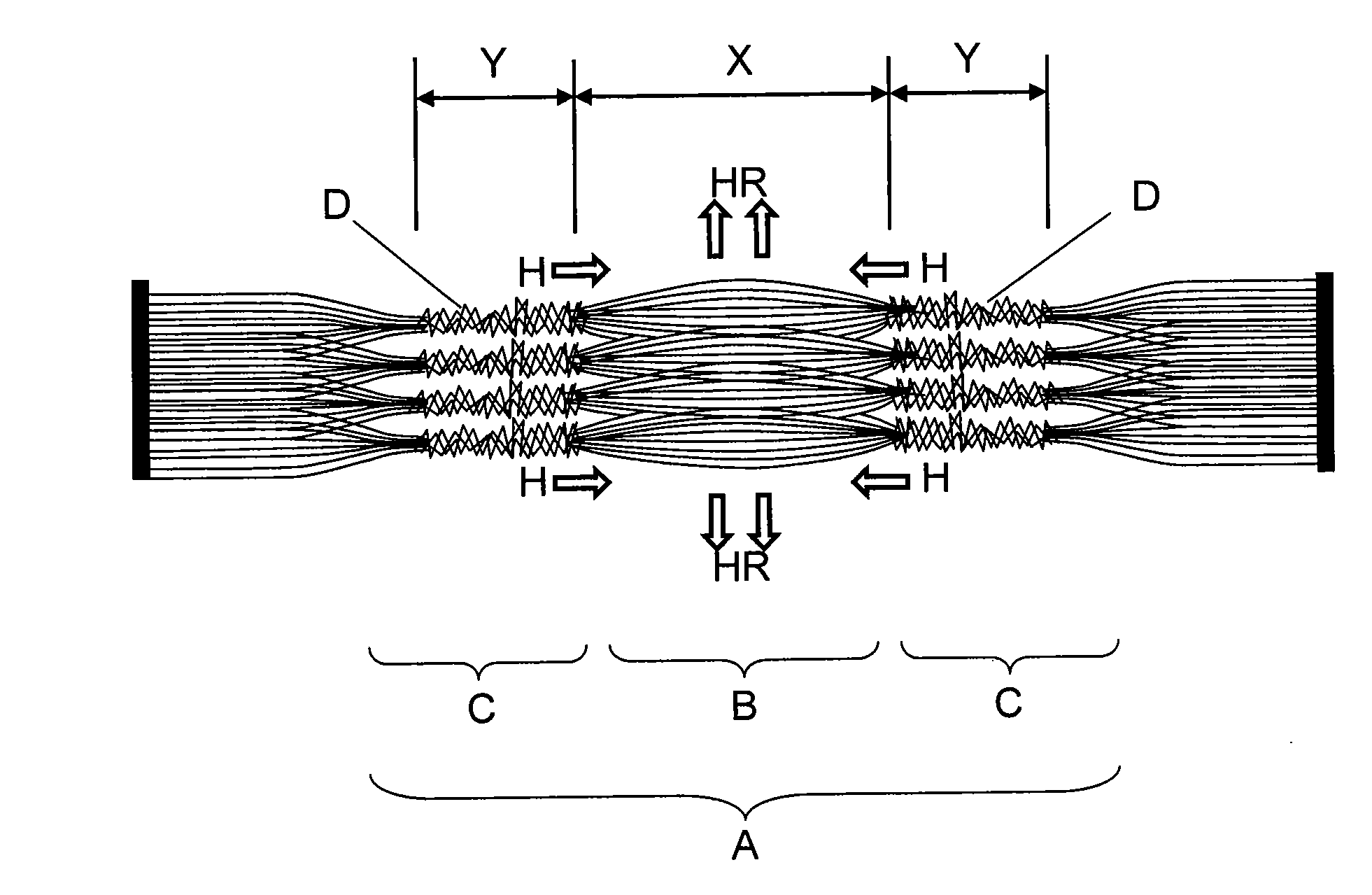Fiber bundle with pieced part, process for producing same, and process for producing carbon fiber
- Summary
- Abstract
- Description
- Claims
- Application Information
AI Technical Summary
Benefits of technology
Problems solved by technology
Method used
Image
Examples
example 1
[0143]An end portion 5 of a first precursor fiber bundle FB1 and an end portion 6 of a second precursor fiber bundle FB2 were superposed over a length of 400 mm as the size of a superposed fiber bundle portion. The fiber bundle joining apparatus shown in FIG. 5 was used to join the two fiber bundles by forming the superposed fiber bundle portion. Three fiber interlacing devices 51 were used to perform this. In each fiber interlacing device 51, the fluid jetting holes in the first fluid jetting hole series 71 and the second fluid jetting hole series 72 had a diameter of 1.5 mm, and the spacing between the fluid jetting holes was 2.5 mm. The distance (hole series spacing) L between the two fluid jetting hole series 71 and 72 was 30 mm as measured in the length direction of the fiber bundles. The superposed first and second fiber bundles FB1 and FB2 were relaxed by 9.0% in the fiber bundle relaxing device 53 using a round bar.
[0144]Subsequently, air jets compressed at a pressure of 0.4...
example 2
[0147]The same first precursor fiber bundle FB1 and second precursor fiber bundle FB2 as in Example 1 were prepared. Elsewhere, a joint fiber bundle JFB was prepared from a carbon fiber bundle that comprised 24,000 filaments and had a heat conductivity of 55 W / m·K. The three fiber bundles prepared were superposed in a state as shown in FIG. 3. Both the superposed portion of the first precursor fiber bundle FB1 and the carbon fiber bundle JFB, and the superposed portion of the second precursor fiber bundle FB1 and the carbon fiber bundle JFB, had a length of 400 mm. The distance between the end of the first precursor fiber bundle FB1 and the end of the second precursor fiber bundle FB2 was 500 mm.
[0148]The fiber bundle joining apparatus shown in FIG. 5 was used to join the first precursor fiber bundle FB1 and the carbon fiber bundle JFB and join the second precursor fiber bundle FB1 and the carbon fiber bundle JFB in the superposed fiber bundle portion. Here, the same three fiber int...
example 3
[0157]An end portion of a first precursor fiber bundle FB1 and an end portion of a second precursor fiber bundle FB2, opposed to each other with a spacing, were bridged and joined by a joint fiber bundle JFB, which was a carbon fiber bundle comprising 48,000, 24,000, or 12,000 filaments to prepare three fiber-joint-portion-containing fiber bundle samples. In joining the superposed fiber bundles, the fiber bundles were superposed first, and relaxed by 9.0% in their length direction, and subsequently three fiber interlacing devices 51 were used to join the fiber bundles in the superposed portion. Each fiber interlacing device 51 had a first fluid jetting hole series 71 and a second fluid jetting hole series 72. From the fluid jetting holes located at intervals to form each fluid jetting hole series, air jets compressed at a pressure of 0.4 MPa were emitted for two seconds to interlace the multiple fibers in each fiber bundle in the superposed portion. This produced a fiber-joint-porti...
PUM
| Property | Measurement | Unit |
|---|---|---|
| Length | aaaaa | aaaaa |
| Length | aaaaa | aaaaa |
| Length | aaaaa | aaaaa |
Abstract
Description
Claims
Application Information
 Login to View More
Login to View More - R&D
- Intellectual Property
- Life Sciences
- Materials
- Tech Scout
- Unparalleled Data Quality
- Higher Quality Content
- 60% Fewer Hallucinations
Browse by: Latest US Patents, China's latest patents, Technical Efficacy Thesaurus, Application Domain, Technology Topic, Popular Technical Reports.
© 2025 PatSnap. All rights reserved.Legal|Privacy policy|Modern Slavery Act Transparency Statement|Sitemap|About US| Contact US: help@patsnap.com



